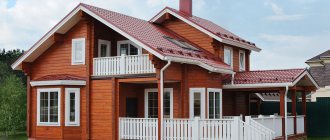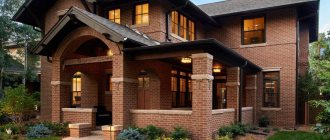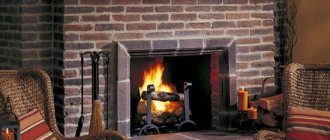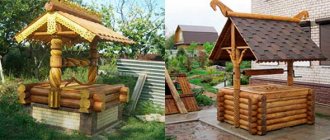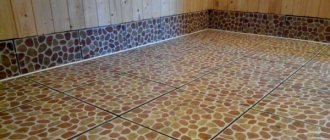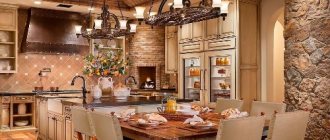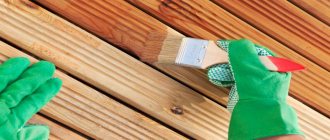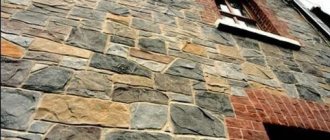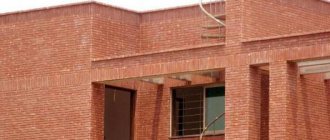Materials and tools
To complete the work, you will need inexpensive materials to imitate brickwork and simple accessible tools, namely:
- spatula width 200 mm and 80 mm;
- flute tassels 5 and 3.5 cm wide;
- paint roller;
- paint tray;
- building level 2 m long;
- long metal ruler;
- tape measure and pencil;
- cardboard brick template;
- primer;
- masking tape 1 or 1.5 cm wide;
- dry mixture Rotbant;
- tex paint;
- color tex: red-brown, red, orange, black;
- matte acrylic varnish;
- electric drill with whisk;
- kitchen sponge;
- sandpaper #180 and 240;
- bucket for mixing the solution;
- container for mixing paint.
In addition to this tool, to imitate brickwork with your own hands, depending on the complexity of the work and the quality of the wall surface, you may need additional tools and materials. The purchased spatulas must be prepared for work: sharpen the sharp corners with sandpaper and sharpen them. You can use #180 sandpaper to sharpen spatulas.
What glue should I use to glue tiles to the stove?
Having chosen a tile, you need to select a composition to securely fix it on the walls. To answer the question: how to glue tiles to the stove, we follow several recommendations:
- it is better to purchase a ready-made composition so as not to perform complex calculations on the amount of materials;
- we select glue produced for lining fireplaces or stoves;
- It is recommended to use heat-resistant mastic “Standard” with a heating temperature level of 10,000. We take into account the material consumption of 1.5 kg per 1 m2;
- glue “Plitonit – SupenrKamin” is produced using a dry mixture, which we dilute before work;
- Atlas-Plus hardens within a few hours. Consumption rate 2 kg per 1 m2;
- “Fixator” adhesive is recommended for use when lining garden house stoves. It can withstand high temperatures during furnace operation and cold during long breaks.
Preparation for painting: important requirements
When carrying out work on painting the surface, it is worth considering that brick is a porous material. To completely dry and weather the wall, the house must stand for a long time in its original form.
For external work
When choosing to paint an external brick wall, you should consider the following points:
It is not advisable to paint fresh masonry. The surface must fully go through the stages of drying, weathering and leaching. This may take a year. Before painting, prepare the wall surface; it must be clean. What color should I paint the decorative plaster in the hallway? To do this, remove salt stains, wash with soapy water and allow to dry thoroughly. Excess moisture will evaporate from the surface within a week. Painting brickwork creates a modern and trendy home style
Attention is diverted from small defects in the walls. You can choose a paint color that matches other buildings on the site.
For interior work
Large and clearly visible imperfections are better to be filled or plastered. Although the brickwork should be rough with a surface without large cracks or chips, it is easier to paint this way, and the wall looks neater.
The surface should be carefully primed. Choose a deep penetration primer that creates a dense water-repellent film.
Brick, as a building material, is not entirely suitable for painting. This is due to its porous structure. In the future, removing paint from it and plastering the surface will be quite problematic.
The only option is to repaint the wall a different color.
Classification depending on friction coefficient
The anti-slip level of floor tile products is determined by the friction coefficient R. This is a European standard, which is formed based on the results of practical experiments. The number next to the letter R determines in which zone such a facing surface is used. R9 – This includes entrance areas, trading floors, corridors, halls, stairs, food outlets, pharmacies, hospitals, laboratories, hairdressers, dry cleaners. R10 – Places with street trading, warehouses with food products, open warehouses, kitchens in public catering establishments, walkways and toilets.
Iceberg
R11 – Places where foods with vegetable fats are stored, produced and packaged, juices, meat processing, garages where moisture may enter, dyeing shops, and laundries. R12 - Areas for the production of dairy products, vegetable and animal oils, loading platforms, parking lots for fire service vehicles, gas stations at enterprises. R13 – Special purpose areas at industrial enterprises.
What about other ways to decorate brick walls?
On the modern building materials market there are many other finishing materials with which you can decorate the interior walls of a room with brickwork. Thus, flexible tiles made to resemble bricks are produced from polyvinyl chloride. Sometimes you can find collections of decorative panels made of MDV/PVC. These types of panels and tiles are characterized by the fact that they are not separate elements, but a kind of panel, the area of which reaches several square meters. All this can be mounted either directly on the wall or on a metal/wood sheathing. The cost of such panels is lower than the same decorative brick, and they are definitely easier to work with.
How to choose the right material for making gypsum tiles?
Gypsum is a material that has long been used for construction and finishing. Its source is natural deposits of this sedimentary rock. These deposits are quite numerous, so gypsum is inexpensive and available to everyone. Construction stores sell rock mined from the depths of the earth and crushed into powder. The gypsum used in construction work does not contain artificial additives, is environmentally friendly and completely safe for humans.
Advantages of gypsum as a finishing material:
- does not emit harmful substances;
- has an affordable price;
- does not burn or be destroyed in the presence of fire;
- has good sound and heat insulation properties;
- takes any form.
The powder packages have markings indicating the parameters of a particular product. The degree of grinding is indicated in Roman numerals:
- coarse grinding – I;
- medium – II;
- small – III.
The strongest and highest quality castings come from finely ground varieties, but this material is more difficult to mix. Coarser grinding is easier to work with, but products made from it are inferior in strength to those cast from fine gypsum. To make tiles, it is recommended to use fine or medium grind powder.
Compressive strength is indicated by numbers from 2 to 25. The higher the number, the stronger the material. The best option is gypsum with a strength of 10 or higher.
Based on the speed of hardening, gypsum is divided into class A (sets in 6 minutes), B (from 6 to 20 minutes) and C (over 20 minutes). The hardening speed can be adjusted by adding various plasticizers during mixing. The hardening process slows down when adding lime, wallpaper glue or washing powder. If you add table salt, the solution hardens faster.
Safety precautions
When working with paints and varnishes, the following rules must be observed:
- You can only work with safety glasses and rubber gloves;
- It is recommended to wear a respirator that protects the respiratory system from harmful varnish vapors;
- storing varnish solution is usually allowed at temperatures from +5 to +25 degrees;
- It is prohibited to apply the composition near an open flame; you cannot smoke near an open container;
- the remaining mixture must not be discharged into the sewer system;
- the room where the varnish mixture is stored must be well ventilated;
- During the application of varnish, the room must be well ventilated.
Coating Methods
Qualified construction workers use different methods of painting decorative gypsum stone:
- mass staining;
- surface application of paint;
- custom coloring to imitate different textures.
Each of them has features of the work and nuances that should be taken into account when painting.
Painting gypsum stone with a brush
To create a decorative coating for stone walls, the classic method of painting using a brush can be used. This surface method is considered the most labor-intensive, but when using an airbrush it becomes faster and easier.
An airbrush is used to apply the pigment more evenly. It is a tool that sprays paint. To adjust the saturation of the shade, it is enough to change the distance from the airbrush to the surface being treated. This technology is used when it is necessary to make smooth transitions between shades or create darker convex areas. You can use multiple airbrushes with different paints to save application time and get unusual results.
Airbrush advantages:
- creates a thin and neat colored layer;
- applies paint more accurately, which protects adjacent surfaces from unnecessary contamination;
- possibility of changing shade;
- the ability to smoothly transition from one color to another.
There are various types of sprayers available for sale. The most affordable airbrush is considered to be a spray gun. If you choose a model with a high-quality compressor, the quality of painting will not be inferior to the result of a more expensive model.
Painting in bulk with an airbrush
This method of coloring is used when independently carrying out work on the production of the material. The technology involves adding a coloring pigment to the solution. Thus, coloring occurs from within the material.
Typically, a proportion of 0.5 parts of pigment per 200 ml of water is used. The resulting mixture must be mixed with an acrylic primer. After drying, a matte varnish should be applied to the surface of the stone to secure the painted layer.
The pigment can also be added in powder form directly to plaster for casting stone. This allows you to eliminate unpleasant situations with small chips on the resulting wall: the white base will not be visible. Working with such products is also convenient, since you don’t need to be afraid that minor defects will be obvious.
The technology is considered the simplest, since the surface should not be covered in several layers. However, along with the advantages, there is also a disadvantage: the surface loses its natural appearance when painted in this way.
Applying pigment to molds
You can do it even simpler and apply the pigment inside the mold. To do this, you need to dilute the pigment and apply it to the entire form or individual areas using a brush. Gypsum solution is poured into the prepared forms. The result is a material with an unusual color.
In some videos, decorative gypsum stone is painted using impregnation, which is also applied to the molds.
Composition selection
Before painting ceramics, you need to choose the right composition. The following types of paints are used to decorate bathroom walls:
- Acrylic. These are the optimal compositions for ceramic tiles. They are not afraid of exposure to moisture, do not wash out, and are harmless to human health, as they do not contain toxic substances. Such products contain antiseptic components, so fungus and mold do not develop in the bathroom. Acrylic paint comes in different colors, glossy and matte.
- Oily. This is a cheap finishing option that can be applied using a sprayer, brush or roller. It takes more than a day for the layer to dry. Oil paint is rarely used to decorate a bathroom. Despite the color variety, such products are not resistant to moisture and will crack over time. The surface should not be washed with soda solution.
- Alkyd. Such compositions dry quickly, do not crack, and are cheap. They are moisture resistant, give a matte or glossy surface, and are not damaged when exposed to detergents. The layer after application performs a decorative function for 4 years and is not afraid of temperature changes. By adding rosin, the product is used to color floor tiles.
- Epoxy . Of all the bathroom paints, they are characterized by maximum durability and are not afraid of moisture. Decorative qualities last 4-5 years. You can wash the surface using any means.
In addition to these compositions, silicone, silicate and latex paints are used for finishing tiles. The first option does not lose its properties when exposed to moisture and does not have a pungent odor. Silicate compounds repel water and do not become dirty, but their color palette is not rich. Silicone paints are vapor permeable, are not afraid of temperature changes, and are able to hide small surface defects due to the elasticity of the coating.
Brick wall decor options
Instead of real brick, other materials are often used for interior decoration in modern decor, the structure of which strongly resembles a brick surface.
Brick walls can be finished using materials and technologies such as:
The advantage of such materials over real brickwork is that they are much lighter than brick and occupy much less volume.
What type of decor is best to choose to reproduce a brick wall? Let's take a closer look at the most popular options for finishing brick walls. Knowing the features of each of them, you can easily create a unique wall decor at home.
Brick construction panels
Construction panels are a real leader among “bricks”, famous for their strength and water resistance. This finishing material has long conquered the exterior finishing market, and has now found its application in interior spaces.
Such imitation panels are made of plastic. This means that they are not afraid of dust, moisture, mold or rust. In addition, such brick panels are highly resistant to alkalis and acids and are not at all afraid of hot droplets of fat, which is why they are often used in the kitchen.
Advantages:
Flaws:
Some panels require additional sheathing, so this design takes up a certain part of the usable space.
Brick panels are mounted both horizontally and vertically, so the pattern on them depends on the method of placement. They are mounted on nails, screws or self-tapping screws. Most of these wall panels are mounted directly on the wall.
In decorative brick panels, each element has its own independent fixation, so an accidentally damaged part of the “bricks” can be replaced in half an hour.
Brick look tiles
An excellent alternative to brick for wall cladding is clinker tiles. This is an inexpensive and very beautiful analogue, made from raw clay. In terms of its characteristics, laying method and thickness, brick tiles are no different from simple tiles.
The surface of the clinker tile is covered with glaze, so the natural color of such a “brick” will remain for a long time, and the matte relief is difficult to damage even with a strong blow.
Advantages:
- the porous structure of this tile is identical to the structure of brick;
- perfectly retains heat indoors.
Flaws:
The clinker tiles are attached to the wall, previously coated with an adhesive solution. A mandatory step is the presence of crosses between the tiles. These crosses fix the seams between the bricks, into which a solution of a mixture of large fractions of cement and sand is then applied. This solution further emphasizes the naturalness of such brickwork.
Brick wallpaper
If you really want to freshen up the room, but time and finances for repairs are limited, brick wallpaper comes to the rescue. This interior looks unusual everywhere:
- in the kitchen;
- in the corridor;
- in a luxurious living room;
- in the little room under the stairs;
- on the balcony;
- in a strict office.
The nuances of coloring
It is worth understanding that there are several cases when you can resort to painting a brick oven. This can be approached from an aesthetic and practical point of view, as well as for safety reasons. From an aesthetic point of view, a stove in a house is necessary not only for heating the house and creating comfort in it, but also for maintaining the interior and creating a special coziness. From a practical point of view, after painting the chimney, heat transfer increases and the surface of the stove is smoothed.
From a safety point of view, microcracks in bricks and, therefore, fires in the house can be avoided by painting.
There are several options for coloring the structure. You can do it:
- enamel;
- with oil paint;
- with olive oil;
- heat-resistant paint.
As for enamel, it is durable, resistant to moisture, interacts well with other materials and is very durable. Experts give the following figures: enamel can withstand about 200 sudden temperature changes.
It is worth noting that the choice of colors is very poor
.
Heat-resistant oil paint for stoves is the best solution, as it has a wide selection of colors, the paint can withstand temperatures of 600 degrees Celsius, is guaranteed to protect bricks from oxidation, and has high strength and durability.
In addition, it is easy to apply and does not require additional priming on the outside. However, there are disadvantages such as unpleasant odor, toxicity and long drying time.
Drying oil is a material that cannot change the color of bricks, but can only make them slightly darker. As for the positive qualities, this coating is reliable and safe. The only downside is the price.
Heat-resistant paint is a coating that can improve the technical characteristics of a brick surface.
The peculiarity of its use is that it can be diluted with gouache to obtain the desired color with a tint
Dye application technology
Km is applied to decorative stone in three ways.
There will be no economical use of dye if it is applied with a brush or roller. The layer does not lie evenly on the gypsum stone. It is convenient to perform several actions with a brush: creating a mosaic, drawing veins, inclusions, emphasizing contrasting areas, restoring individual places.
Working with a brush is not difficult. The pile is immersed in the composition, and the accumulated mass is applied to the tiles. It takes a lot of time and effort to complete the decor; the stone is painted unevenly, but the tiles will visually look like natural material. A brush is convenient for applying varnish to torn areas of the surface, increasing or decreasing the shade by halftone, and defining veins.
The consumption of CM is significantly reduced and the quality of the coating does not decrease if it is applied using a spray gun. Another plus is that the time required for painting is reduced, regardless of the surface texture. An even layer is applied with a spray gun, the color saturation and its depth are adjusted.
Additional recommendations
For work on Tuscan tiles, terracotta, and highly absorbent coatings, it is recommended, if possible, to avoid using varnish until the adhesive has completely cured. The curing process can take months. When laying on a dry screed with cement adhesives, the curing time is significantly shorter.
Before varnishing clinker, it is recommended to first treat the seams. Then, after finishing with varnish, the surface will look perfect if you decide to varnish the tiles.
When it is not possible to replace old tiles with new ones, then using varnishes you can give the floor or wall a completely new look. If the tiles have just been purchased, then the varnish coating will help protect them from moisture, from various mechanical influences, and from temperature changes. Varnishing will give a positive effect, and if the result is not to your liking, you can paint it. The varnish is also good because it can be applied independently.
How to paint decorative stone
To paint gypsum artificial stone, you should follow the stages of work. The sequence consists of several steps:
- Selection of material to be painted.
- Selection of tools.
- Preparing the stone surface.
- Applying paint.
- Drying.
This step-by-step process will allow you to get the desired result.
Tool selection
If the paint material has already been decided, you can start choosing a tool. The most important thing is a brush or airbrush. An ordinary sponge can be used for work.
In addition to the main tool you will need:
- container for mixing pigment;
- gloves and protective clothing;
- rags;
- additional brushes for decoration.
Sponges can be added if necessary.
Preparing the stone
Before painting a decorative gypsum stone, it should be prepared. To do this you need to perform several manipulations:
- Remove the previous layer of paint.
- Sand the surface.
- Blow off with a compressor or treat with a rag.
- Apply primer at least twice.
When working with new material, you need to wash and saturate it.
Coating
When painting, you should take into account the recommendations of builders:
- Fragments must be processed separately.
- When working with a finished wall, a relief is used or covered in two tones. This will prevent homogeneity.
- It is better to use a spray gun to increase the speed of work. The surface becomes evenly colored. It is considered inappropriate to work with embossed surfaces with a brush.
- If conditions permit, you can immerse the parts in the coloring composition.
- If we are painting a decorative stone made of gypsum, we should not refuse to test paint. This way you can evaluate the result in advance.
These tips will help you avoid problems when painting.
Instructions for use
Before applying varnish, it is necessary to prepare the floor surface. It must be completely dry and free of dust or other contaminants. Any remaining cement must be removed and the seams leveled.
Apply the varnish as evenly as possible. Do not pour out all the material at once and then distribute it - this can lead to sagging and stains. Then the layer is given time to absorb - 2-3 minutes, the excess is removed with a rag.
If terracotta, Tuscan tiles and other highly absorbent materials are being varnished, the surface should be treated one more time to obtain a high-quality result. If the tile absorbs poorly, then the composition is applied only with soft fabrics to avoid streaks that can spoil the result.
These coatings can also be used for pre-treatment of Tuscan tiles and easily absorbent tiles before laying them on an adhesive or cement mixture. This will help remove the finished tiles. But terracotta should not be pre-treated - there is a risk of fading.
Process
On the one hand, there is nothing complicated or tricky in this process, so even a child can handle it. At the same time, it is one of the most important and critical stages that can affect the appearance of artificial tiles. Therefore, you cannot approach the work without a serious approach and a bit of imagination, otherwise you can simply ruin the entire project, including the casting.
Make sure that in the second case the material is not stained with glue or joint filler. If you don’t want to worry about this, open the tiles first with varnish.
Water-based acrylic paints for working with decorative gypsum stone
Painting each tile separately is best done by those who do not yet have the proper experience in this craft. If you are already skilled at this, paint it directly after laying it on the wall. In this case, you will be able to better see the final drawing; the gypsum tiles will be colored more naturally and therefore fit better into the interior.
Remember also that this method requires:
- responsible approach;
- preliminary sketching of a painting plan;
- correctly selected color combinations;
- calculations of light and shadows.
In this situation, you will get some more shades of these colors, so you should not mix many different shades. Be aware that plaster absorbs paint differently, so one color can produce multiple finishes.
Paint application process
There are a sufficient number of technologies for painting artificial gypsum tiles, including airbrushes and spray guns. In this article we will look at several effective and at the same time simple methods that will show how to paint artificial stone at home or in production.
Filling the seams with a special mixture
The final stage of facing the heating block is grouting the joints. For this construction operation, a special composition is used, which, when hardened, has good resistance to aggressive substances, such as water or household detergents. After pouring a certain amount of powder into water, it should be mixed manually to the desired consistency.
Using a rubber spatula, push the finished mixture into the space between the tiles (before this, the crosses must be removed), after which, by running the corner of the tool along the seam, they give it a beautiful shape, distributing the working mass evenly.
Particular attention must be paid to places such as the windows of stove wells, having beautifully framed them using a grout mixture.
Having wiped all the seams, you should wait until the substance filling them becomes solid, after which all that remains is to remove its remains from the tile with a rag and enjoy the new beautiful look of your heating structure.
As can be seen from the above description of the work process, tiling a stove yourself with ceramic tiles is not a difficult task. It is only important to strictly adhere to the technological sequence. Of course, when performing such work for the first time, you should not expect ideal results. Still, you don’t need to worry too much about something that didn’t work out the way you would like, because, most likely, only you see these shortcomings, and to those around you, your heating structure looks very elegant.
Perhaps one of your friends will even ask you to help with renovations in their home, and over time, your new specialty will turn out to be a good help, providing you with an additional source of income.
How to paint false bricks
The imitation of masonry can be made in a single color - white, light brown or beige. The most natural look will be imitation of silicate, clinker or red brick. Using the same method, you can update a boring monochromatic plaster coating with imitation bricks or “wild stone”.
If the artificial masonry looks somehow “boring”, you can manually lighten or darken individual blocks. The most attractive look is the combination of fragments that are more different in saturation in one color scheme - milky, terracotta, sand or rocky gray. You can add pigment to the water-based whitewash for bricks on the corridor wall. The surface can be slightly shaded with a sprayer with a bronze or metallic effect.
Depending on the desired effect, coloring is carried out using different devices:
- Spray bottle;
- Spray paint;
- Paint brush;
- Whitewash brush;
- Porous sponge;
- Roller with decorative attachments.
To treat a solid wall, it is recommended to treat it with a primer or special impregnation. Finish coating – acrylic, silicate, any interior paint recommended for decorative plaster (same base).
The most natural look will be imitation of silicate, clinker or red brick.
Advantages and disadvantages
Painting decorative stone has its pros and cons:
| Advantages | Flaws |
|
|
Attention Painting requires not only creativity, but also skill. To select the future appearance of the cladding as accurately as possible, you can use online works, which are presented with step-by-step instructions.
Varnish consumption
If the surface to be treated is porous, then to obtain a durable coating it is necessary to apply two or three layers.
The consumption of the product is 100-200 g/sq.m., but when applying a second layer it increases by another 100 g/sq.m.
Hard tile bricks
An imitation of a brick wall can be successfully achieved using hard tiles. There are various options for hard tiles; as a rule, they are all installed using identical technology.
Types of hard tiles
The following types of decorative bricks are considered the most popular:
- Gypsum tiles. Such tiles are most common among consumers. Due to the plasticity of gypsum mortar, bricks of various textures are produced. The disadvantages include the fragility of the material, as well as the inability to use in rooms with high humidity.
- Cement tiles. This material will be more expensive than gypsum tiles, but this type has a number of advantages, such as high strength, the possibility of installation in wet rooms, and susceptibility to care and washing.
- Clinker tiles. The most similar imitation of brick will be on the wall when using the clinker variety. The price tag for this tile is significantly higher than other options, but the difference in cost is offset by the following advantages: the possibility of cladding facades, high strength, resistance to abrasion and ultraviolet radiation.
Gypsum brick tiles
Tile installation technology
The rules and technology for facing a wall with hard tiles differ little from the technology for laying soft material. The difference will be hidden behind the thickness of the glue and the process of cutting the material. According to the first point, the thickness should not exceed 0.5 millimeters, and hard tiles can only be cut with diamond-coated circles. The exception is gypsum tiles - they are easy to cut with a knife.
Installation of rigid brick tiles
How to make a mold for casting plaster tiles
Brick finishes can be made from homemade tiles. To do this, you need to take an impression from several individual bricks, thereby preparing the mold for casting. A gypsum solution will be poured into the resulting form, after which the finished decorative stone can be mounted on the wall.
The side of the brick that is taken as a sample is covered with grease or heated wax mixed with kerosene. This is necessary in order to prevent the silicone from sticking to the surface. As soon as the layout dries, the treated side is covered with a layer of silicone sealant, 1-1.5 mm thick. The mold is set aside until the silicone has completely polymerized.
After the silicone has hardened, the mold is coated with polyurethane foam. After the foam has hardened, the sample is removed and the bottom of the mold is leveled.
A gypsum solution is poured into ready-made molds, which sets very quickly and takes on the appearance of a finished finishing material. If you have 10 molds, you can make several square meters of decorative stone in a couple of days.
Brick tile mold
Classification of ceramic tiles depending on abrasion class
The abrasion class of tiles or the wear resistance class of glazed ceramics is determined by one of 5 PEI groups according to the international standard EN ISO 10545.7 . PEI is an acronym for the American Ceramic Materials Research and Testing Institute. The tiles are assigned the appropriate class based on the results of the experiments. To do this, the surface of the facing material is exposed to an abrasive that imitates the action of the soles of human shoes. Each class shows in which rooms such cladding products should be used.
Metallica
Characteristics of abrasion classes:
- PEI 1 – these are rooms with a minimum amount of movement, where people walk barefoot or wear slippers, such as a bathroom, toilet
- PEI 2 – for rooms in the house where slippers are also worn. This includes kitchens and bedrooms. This class is not intended for use in kitchens, hallways and corridors.
- PEI 3 – premises with average traffic, mainly not in street shoes, but in house shoes. Suitable for residential premises, hotels, offices with a small flow of people.
- PEI 4 - this class includes places with medium traffic intensity with a transition to active traffic. Interiors of the residential sector, offices, shopping centers, cafes, restaurants, hotels are suitable here.
- PEI 5 - this abrasion class characterizes the most durable slabs that are suitable for any room. This also includes public places with high traffic, such as large shopping centers, airports, and train stations.
Old marble
If you like the effect of aging, you can treat the product so that the material becomes similar to old marble.
The work is carried out in a certain order:
The purchased stone will need to be kept for two days in a dark room. If you created the product yourself, dry it thoroughly (maximum at 55 degrees). Warm up the drying oil
This should be done very carefully and you will need to use gloves when working. The material is applied using a flute brush. It is recommended to apply it in 2 layers
Try not to leave unimpregnated areas: the product should be processed evenly. After some time, the surface will look like old marble.
Final works
At this stage of work:
- We remove all the crosses from the grooves;
- We put 2-3 kg of firewood into the firebox and dry the surfaces before completing the work. We carry out this operation at least 3 times, allowing the oven to cool completely after each stage;
- Prepare a solution of heat-resistant grout or use mastic. If necessary, you can add a color pigment to the composition to shade or highlight the main color of the tile. We fill the seams using a small rubber spatula. Immediately remove excess solution using a dampened cloth. If a heat-resistant sealant is used, fill the seams using a mounting gun;
- We treat the seams with a special water-repellent composition based on silicon;
- Let the grout harden a little, and after 2-3 hours we finally clean the front surfaces of the oven.
Why paint a brick wall?
Artificial ceramic stone is a popular material for construction work. For the construction of walls, ordinary brick is used, the surface of which is rough and unattractive. When choosing masonry as a decorative element, it is necessary to improve the aesthetic perception of the surface. Painting brick white looks great in rooms decorated in loft, modern, and high-tech styles. The characteristic relief of the walls is preserved, but its presentability is enhanced.
Photo 1. Painting bricks white makes the room brighter
Brick facades of buildings are painted for various reasons:
- As a result of long-term use, the original appearance has been lost.
- The masonry has partially collapsed; repairs require plastering and color restoration.
- Construction of extensions where the creation of an overall harmonious composition is required.
- The desire to change the decorative appearance of the structure is also a powerful argument (photo 2).
Photo 2. Changing the decorative appearance of the facade by painting
Tools and materials
After you have decided on the painting material, you need to prepare your working tools. Usually a brush or an airbrush is chosen. Painting can be done with any tool, for example, to create a coating, some use an ordinary sponge. But the advantage is on the side of the airbrush:
- creates a thin and neat layer of paint;
- does not smear surfaces during operation;
- when adjusting the spraying distance, one and the same paint looks different on gypsum stone;
- The surface color is even and uniform.
So, for painting you will need:
- dye;
- containers for water and mixing paint;
- gloves;
- rags;
- brushes and sponges (for decoration);
- airbrush (if the work will be done by him).
Tip: Construction stores offer a wide selection of airbrushes. They are suitable for painting almost any surface. You can also choose a cheap option - a spray gun, it will cope with painting artificial stone
The main thing when buying is to pay attention to the following: the strength and power of the compressor.
A brush is not the best option for painting for the following reasons:
- leaves streaks and drops;
- professionals don't use it;
- a thick layer of paint remains;
- individual gypsum elements may not be saturated with the next layer.
It is better to use a brush when it is necessary to treat torn areas.
We paint the product “to look like stone”
A short lesson in painting like a stone.
We are not interested in painting to look like brick or just rubble stone. The question is how to paint specifically for decorative stone, marble, jasper, malachite, and so on. This algorithm and sequence is the basis of the direction. By understanding and trying, you can learn to imitate different options and textures.
What we need for painting: 1) Brushes 001, 1,2 2) A sponge, or a piece of foam rubber, or a toothbrush 3) Acrylic or oil paints, whichever you prefer. Oil paints allow for deep, layered textures and require more experience working with paints. For a beginner, you can start with acrylic or practice on paper with simple watercolors. 4) Well, actually, what are we going to describe?
1) Step one
We apply matte white primer to the product we need. Then we apply the first primary color, which we will use for painting. In our case it is black.
2) Step two
Using a sponge, a piece of foam rubber or a toothbrush, apply the first texture. The color of the texture depends on what we want to get in the end. To imitate jasper, you can use white, gray and purple colors, applying them one after another. In our case, we will use two colors: light green (pale green) and light green (variations and color shades of green can be any, do not be afraid to experiment with color). Apply the first layer and let it dry. When using acrylic paints, this will take 10-15 minutes.
3) Step three
After the prepared base has dried, we begin to draw lines. It is advisable to draw lines with brushes of varying fineness from 001 to 2 (brush size). Direction, discontinuity, thickness of lines - it all depends on your imagination. To make it easier, imagine that you are drawing lightning breaks
The color of the lines also depends on what stone you are imitating. In our case, we mix a little green into the white color and draw lightning.
After complete drying, we apply a layer of glossy varnish.
An example of painting under “gray marble”.
A small, as they say now, life hack
If you have no desire to paint the surface like a stone, then you can create an imitation of the structure of an ornamental stone by simply mixing two different colors of polymer clay
I hope the lesson was interesting and instructive. I invite you to visit my page and see my work.
List of tools
To create a decorative element that attracts attention with your own hands, you need to use tools that allow you to paint. The main devices include:
The main devices include:
- airbrush or spray gun;
- brushes and rollers;
- sandpaper or sanding machine.
Most often, an airbrush is used for painting.
With an airbrush, you can give the stone different shades - to do this, you simply adjust the flow of paint and the distance from the tool to the working surface. For painting the material, a conventional airbrush with a compressor equipped with oil cooling and an automatic pressure regulator is suitable.
It is very rare to paint the entire facing stone with a brush, because the device leaves streaks and unsightly stains. A brush is an excellent tool for highlighting certain areas.
Painting artificial stone proceeds efficiently, without any hiccups, if a set of tools is prepared in advance. It differs in the number of required items depending on the quality of the surface. For the old finish, more of them are prepared, for the new stone cladding - fewer of them. Basic list of tools:
- remove dust and dirt from the surface with a vacuum cleaner;
- the coating is sanded with sandpaper or a grinder;
- hard-to-reach places on the wall with decoration or its individual elements are painted with a sponge and brush;
- saves money and applies CM evenly with a sprayer.
Preparatory stage
If the choice of which paint to cover the tiles has been made, then the surface is prepared before applying it. The procedure includes the following steps:
- cleaning the base from lime or rust deposits, dust and dirt, splashes of water (use an acidic detergent or abrasive powder);
- surface treatment with clean water to remove residual soap solution;
- degreasing the tiles with gasoline or acetone (this is done after the tiles are completely dry);
- treating the base with sandpaper (this improves the adhesion of the paint to the surface);
- removing dust using a vacuum cleaner or a cloth;
- applying primer and puttying joints.
When cleaning tiles, special attention is paid to the seams between the tiles, because dirt accumulates most of all there.
Where is painting allowed?
Not all bathroom surfaces are allowed to be painted. You should not use this type of finish in places that will be in constant contact with water: the ceiling, flooring, walls in the shower stall. Even durable paint in such conditions begins to crack, fade and lose its decorative effect.
Required Tools
After the types of paints for the bathroom , the tools are prepared. The following equipment is required for operation:
- foam rubber sponge, dry rags;
- a set of paint brushes, a short-hair roller;
- paint tray;
- stationery knife, masking tape;
- protective film;
- fine-grain sandpaper;
- stencils.
The paint is pre-mixed. Protective clothing, goggles and a respirator are also required.
Features of composition selection
If the tiles must shine, then it is better to choose glossy types of compositions. Satin paints are used for a semi-matte surface with a velvety effect. Water drops or streaks are not visible on such a surface.
Briefly about the main thing
Gypsum for decorative stone is used in almost every modern design. This material is a budget and modernized version of conventional brick. It is lighter, easier to install and suitable for all types of surfaces
That is why when choosing an artificial surface, attention is paid to gypsum stone
A large assortment allows you to choose the material for each room. But the types are very different from each other, so it is worth studying in detail the properties of each and comparing them with the technical characteristics of the room
You can do the installation yourself, but it is important to follow all the rules and strictly follow the instructions. Only then will gypsum tiles become an excellent addition to the interior of the house
Stone impregnation
Make sure the surface of the stone is clean and dry. You can start hydrophobic impregnation.
Impregnation of artificial stone prevents chipping, protects against excessive moisture, premature abrasion, closes pores and strengthens the structure of the stone. Without soaking, the paint will lie unevenly, with “camouflage” spots, and its consumption will also increase significantly.
Hydrophobic compounds come in different forms. It is better to select the most suitable composition for your stone model, for example, choose latex impregnation.
Impregnate the stone at least twice, in as uniform a layer as possible, using brushes, a roller, a sponge or a spray gun for this purpose. After processing, while any of the layers dry, do not allow water to come into contact with the stone.
